Banff National Park, nestled in the heart of the Canadian Rockies, is a nature lover’s playground. While the stunning mountain landscapes don’t change, the weather and seasons in Banff National Park can have a big impact on your trip. Finding the best time to visit Banff National Park for your ideal trip requires an overview of what to expect in each of the seasons and each of the months in Banff.
Whether you are looking for the best time to go to Banff to avoid crowds or the best time to ski in Banff, you’ll find your answer here! I’ll first review each of the seasons in Banff, then break it down even further to what to expect in each month in Banff.
As we review the Banff weather by month, it’s important to know that conditions can vary from year to year, so it’s always a good idea to check the latest forecasts before your visit. Keep in mind that Banff National Park is a year-round destination, and the best time of year to visit Banff National Park depends on your personal preferences and the activities you most want to do!

This post contains compensated links.
Banff in Spring
While spring typically means the first signs of life, in Banff you’ll have to wait just a little bit longer. April and May will have glimpses of spring, but winter will still very much be present. The ski hills are still open into May and hiking trails will be covered in snow and ice.
In the valley bottom, you will start to see signs of spring. Around mid-May you can start to see some wild flowers emerge in lower elevation places like Bow Valley Provincial Park (along the TransCanada Highway between Calgary and Banff).

Banff in April
The temperatures in Banff in April will see daily highs around 36°F to 55°F (2°C to 13°C) and overnight lows dropping around 16°F to 28°F (-9°C to -2°C). You can still expect snow fall and also rain in April.
With milder weather the anticipation for spring is high, but there’s still some waiting to do. April is an ideal time for spring skiing in Banff with warmer and longer days. Higher elevation trails will be snow-covered and avalanche risk can still be present.
April is a key planning month in Banff, when shuttle reservations (like the Moraine Lake Shuttle and Lake Louise Shuttle) become available for the summer months.
Read More
Want to know what’s great about visiting Banff in April? Read our full guide to visiting Banff in April!

Banff in May
The temperatures in Banff in May will start to warmer temperatures with daily highs averaging to 49°F to 68°F (9°C to 20°C) and overnight lows dropping around 27°F to 37°F (-3°C to 3°C). It’s not unusual to get a big snowfall in May or rain.
Mid-May is when the park really starts to open up. The transportation options will increase, new activities and tours will start and some wildflowers may even start to be seen at lower elevations. Visiting Banff in May is nice as wildlife will also become more active and seen more frequently.
Read More
Want to know what’s great about visiting Banff in May? Read our full guide to visiting Banff in May!

Banff in June
The temperatures in Banff in June will see daily highs 55°F to 72°F (13°C to 22°C) and overnight lows ranging from 34°F to 44°F (1°C to 7°C). Rain is common in June.
Banff in June is the beginning of peak tourist season. Moraine Lake Road opens up and crowds will flock to both Lake Louise and Moraine Lake. Hiking trails may still have some snow at higher elevations, but warm temperatures allow for more outdoor activities and camping. June is also an excellent month for mountain biking in Banff and area.
June has some of the longest daylight hours allowing for plenty of time for exploring! You’ll need to stay up late and get up very early to catch those sunsets and sunrises.
Read More
Want to know what’s great about visiting Banff in June? Read our full guide to visiting Banff in June!

Local Tip
There are several apps that we recommend for your trip to Banff. Our top recommended apps for Banff will not only help you navigate the parks but also enhance your trip!
Banff in Summer
Summer in Banff is peak tourist season and the busiest time of all. And for good reason, the park is at it’s most beautiful with stunning blue lakes, creating the perfect picturesque backdrop for picnics. Long days and warm temperatures leave plenty of time for exploring the far reaches of the park.
Just be prepared for crowds at the most popular places and having more difficulty finding a quiet hiking trail. It’s also one of the more expensive times to come as accommodations and tours are in high demand.
Read More
Read our full post on visiting Banff in the summer. It includes everything you need to know and all the best things to do!

Banff in July
The temperatures in Banff in July is one of the months with warmest weather with daily highs from 64°F to 75°F (18°C to 24°C) and overnight lows ranging from 41°F to 50°F (5°C to 10°C). Rain can be expected in July.
Mid-July to mid-August you can expect to see Banff in full bloom with alpine wildflowers along the hiking trails. July also presents plenty of opportunities to see wildlife around Banff. It’s a great time for all the outdoor activities in Banff, just make sure to carry plenty of water on those extra warm days!


Need Help with Your Banff Itinerary?
We’ve created expertly curated itineraries for Banff and area. Choose from our 3 Day “See It All” to our 10 Day Ultimate Banff and Jasper Itinerary.
Banff in August
The temperatures in Banff in August have typical daily highs of 62°F to 74°F (17°C to 23°C) and overnight lows ranging from 39°F to 48°F (4°C to 9°C). Precipitation is similar as July.
August is very similar to July, with great weather and wildflowers. The crowds remain high throughout July and August, and even into September. August also continues to be the best time for hiking, stand up paddle boarding and all the outdoor activities available in the park.
While it might be crowded, summer truly is one of the best times to visit Banff.
Read More
July and August are a great time to get out on the Banff lakes! Read our full post on the best places for stand up paddle boarding in Banff.
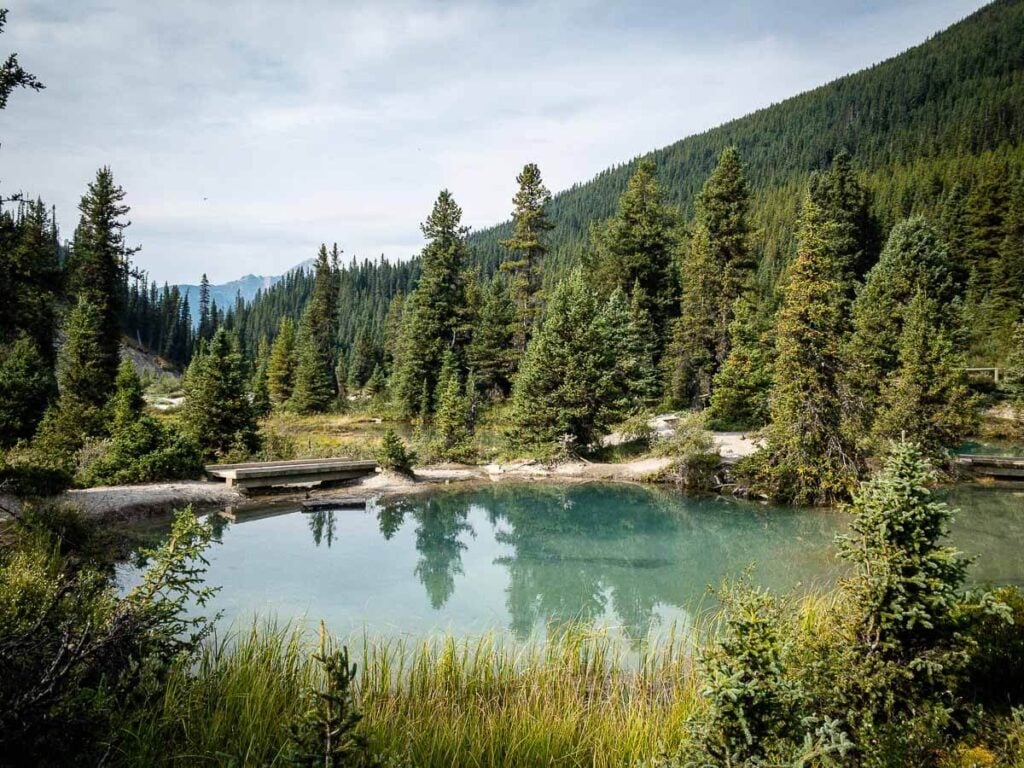
Banff in September
The temperatures in Banff in September starts to get cooler with daily highs averaging 54°F to 66°F (12°C to 19°C) and overnight lows ranging from 32°F to 40°F (0°C to 4°C). September is a drier month and one of the best months to visit Banff.
While the crowds do start to be less early in September, as families transition back to school, come mid September will see a resurgence on the hiking trails as larch season begins. The changing larch trees will have locals and visitors alike out enjoying some of the best larch hikes in Banff National Park and the surrounding area.
Read More
Larch season is our FAVOURITE time for hiking. Check out our favourite Alberta larch hikes here.
Some snow can be expected in September and especially at higher elevations.
Bears are actively feeding to prepare for winter and the elk rut season begins. It’s crucial to give all the animals the space they need.
Read More
While we tend to go on about larch hikes, there’s more to know about visiting Banff in September!

Banff in Fall
The start of October will continue to see the beautiful landscapes adorned with yellow larch trees and give hikers more opportunities to do their favourite larch hikes. Though it won’t last long which is similar to some activities in Banff National Park, as some of the popular attractions close down for the winter.
It’s important to know that while some places do close down in October, Banff is still a year round destination. Some close to prepare for the winter season and others close because of the danger of avalanches in the winter months.
October will see bears still actively feeding in preparation for winter and the elk rut season continues.
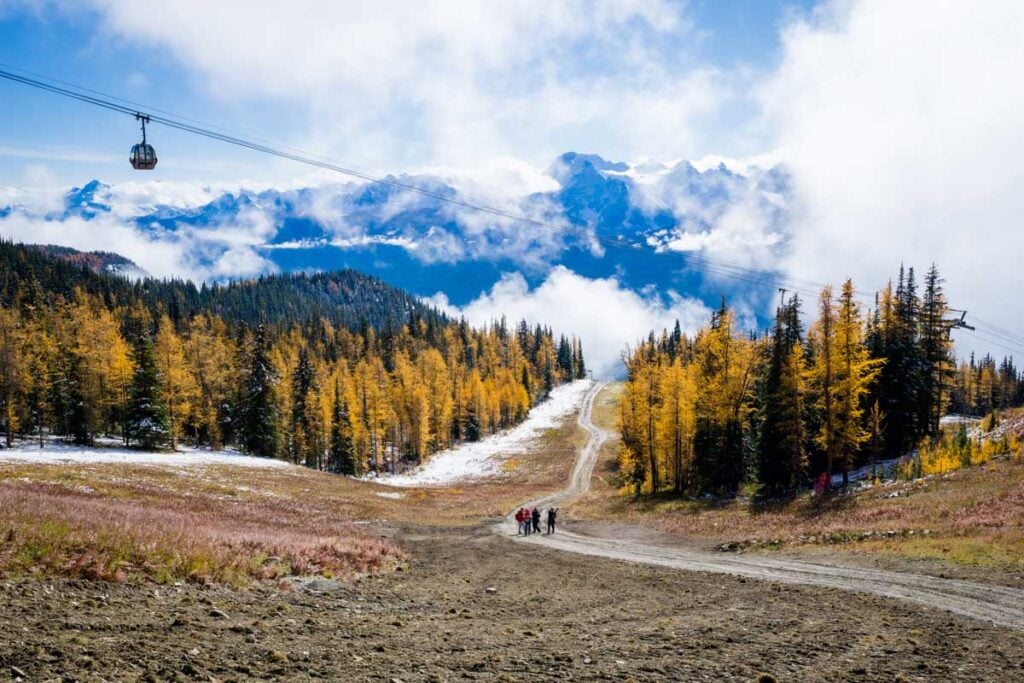
Banff in October
The temperatures in Banff in October continue to get cooler with daily highs averaging Typically 42°F to 56°F (6°C to 13°C) and overnight lows averaging from 21°F to 31°F (-6°C to -1°C).
In the early days of October in Banff, you’ll still get to enjoy some fall colours. As the days go on, the larch trees will lose all their needles and the trees will be bare of leaves.
As it gets cooler, seeing snow at higher elevations is more frequent. By Canadian Thanksgiving (the second Monday of October), there will be come closures and shifts in schedules. The teahouses at Lake Louise will close, shuttles to Moraine Lake will stop as Moraine Lake Road closes, and the Roam Bus will have less routes and schedules will be adjusted for this quieter time.
Read More
October can still be a great time to visit Banff National Park. To make sure you are prepared for a fall visit, read our post on Banff in October.

Banff in November
The temperatures in Banff in November starts to feel a little more like winter with daily highs averaging 26°F to 41°F (-3°C to 5°C) and overnight lows ranging from 10°F to 21°F (-12°C to -6°C). November will see more snowfall even at lower elevations.
While October can see some snowfall, November will be when there is enough snow for Banff ski resorts to open. Lakes will begin to freeze (with the possibility of some wild ice skating around Banff) and winter sports will begin. It’s also a time to start exercising caution when winter hiking as early season avalanches become a big risk factor. Winter storms can start to make driving a challenge and winter tires are required to drive up the Icefields Parkway.
Bears will start to head closer to their dens as the temperatures drop, but the large grizzlies can be around even until late December and into January in some years.
Late November is also the time when the area begins to prepare for the Christmas season. The Banff Christmas Market is an excellent place to pick up some Banff souvenirs.
Read More
Planning to visit Banff in November? Read our post that includes everything you need to know about visiting Banff this month.

Banff in December
The temperatures in Banff in December see daily highs averaging Typically 12°F to 31°F (-11°C to -1°C) and overnight lows ranging from -4°F to 9°F (-20°C to -13°C). December is one of months where more snowfall is expected in Banff National Park.
December is when it can really start to feel magical in Banff National Park with snowy landscapes and holiday season decorations. The days aren’t just getting colder but they are getting shorter as we head to the shortest day of the year.
Mid-December is when Lake Louise is typically frozen enough for skating. Be prepared for proper winter clothing to get the most enjoyment out of being outside in this winter wonderland.
Read More
What is Banff like in December? You’ll want to read our article on visiting Banff in December to learn everything you need to know!

Banff in Winter
A winter visit to Banff National Park is nothing short of enchanting. The entire region becomes a winter wonderland, blanketed in pristine snow. Skiing, snowboarding, and snowshoeing are popular activities. At the end of the day, warm up with hot cocoa next to a cozy fire or in your hotel’s hot tub. If you love winter sports, then this is the best season to visit Banff.
With the added snowfall, it’s important to know where you are going, be prepared with extra layers and never venture into avalanche terrain unless you know what you are doing and have all the proper gear.

Banff in January
The temperatures in Banff in January has daily highs averaging 0°F to 26°F (-18°C to -3°C) and overnight lows ranging from -15°F to 9°F (-26°C to -13°C). January is similar to December with moderate snowfall.
January is a nice change from the busyness of the holiday season. All the winter sports are in full swing, those extreme cold days can make it difficult to get outside some days.
January also brings the Ice Magic Festival in Lake Louise with amazing ice sculptures from the ice carving competition. This is part of the SnowDays Festival where the town of Banff is decorated with snow sculptures.
January is also a key planning month for Banff National Park, as this is when camping reservations open for the summer months.
Read More
There’s some pretty exciting evens in Banff in January. Click to read everything you need to know about visiting Banff in January.

Banff in February
The temperatures in Banff in February starts to get cooler with daily highs averaging 10°F to 30°F (-12°C to -1°C) and overnight lows ranging from -11°F to 13°F (-24°C to -11°C). Banff continues to see moderate amounts of snowfall in February.
Not a lot changes through the winter months. The conditions remain ideal for skiing and snowboarding at the ski resorts. Other winter activities like snowshoeing, dog sledding and cross country skiing are also still in full swing.

Banff in March
The temperatures in Banff in March starts warm up slightly with daily highs averaging 23°F to 41°F (-5°C to 5°C) and overnight lows ranging from -5°F to 18°F (-21°C to -8°C). Snow can still be expected in March.
While many other parts of the Northern Hemisphere are starting to feel like spring, it’s still very much winter in Banff National Park. You can expect to continue with all the winter activities in Banff throughout much of March.

Read More
Ready to experience winter? That’s right, March is still very much winter in Banff. Read more on visiting Banff in March.
Cheapest Time to Visit Banff
The cheapest time to visit Banff National Park is typically during the shoulder season months, which fall between the peak summer and winter months. Here are some of the most budget-friendly times to plan your visit to Banff National Park:
Late April to early June is the transition from winter to spring in Banff. While some higher elevation trails are likely to still be snow-covered, lower elevation trails and town areas become accessible the further into spring we get. Accommodation rates are often lower compared to the peak summer season, and you can take advantage of spring deals.
Mid October to November is another affordable time to visit Banff. Accommodations prices tend to drop during this season, and you can find some good deals. While some attractions and services may be limited or closed, you can still experience the park’s beauty in a quieter setting. Ski season begins in November, and if you’re into winter sports, you can find good deals on lift tickets and accommodations before the holiday rush.
Just know that weather can be more unpredictable during shoulder seasons, and some trails may be too dangerous and some attractions (like Moraine Lake) are closed.

Best Time to Hike in Banff
The best time for hiking in Banff National Park largely depends on your preferences and the type of hiking experience you’re seeking. Here are some recommendations for different hiking seasons:
Summer is the prime hiking season in Banff. During these months, the weather is warm, and most hiking trails are accessible. The long daylight hours allow for extended hiking adventures, and you can explore a wide range of trails, from easy walks to challenging backcountry routes. The scenery is at its most vibrant with blooming wildflowers and clear alpine lakes. However, be prepared for crowds, especially on popular trails.
You’ll also need to make reservations for campsites well in advance.
Read More
Hiking is one of the best things to do in Banff. Here are some of the best hikes in Banff National Park that should be on your radar.

In late September and early October, you can enjoy the stunning fall colours. Not only is the weather still great at this time, you’ll also have way fewer bugs to contend with. You may encounter snow at higher elevations in September and October. This is one of my favourite times for hiking!
Spring can be a more challenging time for hiking in Banff National Park especially at higher elevations where the trails are still covered in snow. Even at lower elevations, you may find trails to be icy and difficult to navigate (especially early May). Wildflowers will start to appear in areas of the park at very low elevations in May.

Winter still offers some hiking opportunities, though you might need snowshoes for even busy trails right after a snowfall. In the winter, it’s crucial to be prepared for cold temperatures, and if there isn’t enough snow for snowshoes bring along microspikes as the trails will likely be slippery.
Read More
Microspikes and snowshoes are popular winter shoe traction devices. See which kind will suit your style of trip to Banff.
In the winter, there are way fewer accessible trails that don’t venture into avalanche terrain. Not all summer hiking trails make good winter hiking trails. Always do your research before heading out in the winter to ensure you will be in a safe area. Here are some easy winter hikes in Banff National Park.
In addition, some trails become cross-country ski trails in the winter and are no longer hiking trails. Always remain off the groomed cross country ski trails.
Read More
Winter is truly one of my favourite times in Banff National Park. Read about all the best things to do in winter in Banff National Park.
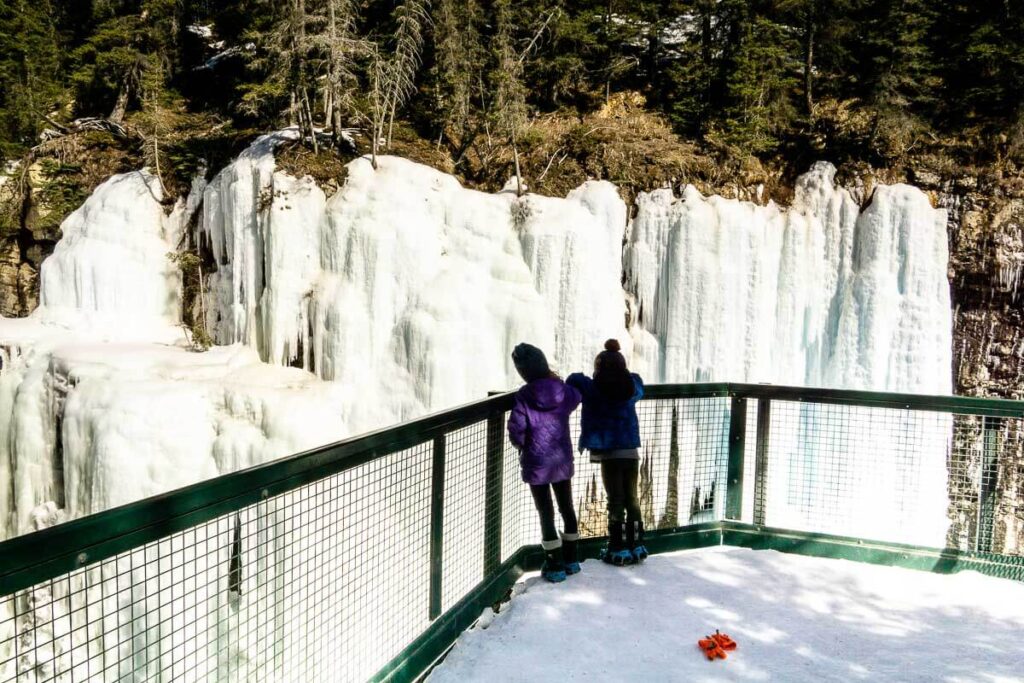
Best Time to See Fall Colours in Banff
The best time to see fall colors in Banff National Park typically occurs in late September to early October. I caution you though because the fall colours in Banff won’t be as colourful and vibrant as we see in Eastern Canada. The trees will not have the variety of reds, oranges and yellows.
Don’t let that prevent you from visiting, because while you’ll see a lot of yellow leaves it’s really quite spectacular. The aspen forests will be glowing with yellow leaves in September. They will begin to change throughout September.
Around the third week of September, the larch trees will change from green to bright green and eventually a golden yellow before the needles will drop. All this with blue lakes, and sometimes even snowy peaks as a backdrop.

Typically the first couple of weeks in October will see the end of fall colours in Banff. Most leaves will have fallen to the ground and the larches will lose their needles.
Keep in mind that the exact timing of fall foliage can vary slightly from year to year depending on the weather conditions. If you’re planning a trip to Banff specifically for fall colors, mid to late September is the best time.

Best Time to View Wildlife in Banff
The best time to visit Banff to see wildlife depends on the type of wildlife you want to see and their seasonal behaviors. Here are some guidelines for wildlife viewing in the park:

Seeing Wildlife in Banff in Spring (Late April to Early June)
Spring in Banff is an excellent time to view wildlife as animals become more active after a long winter. You can expect to see elk, deer, and bighorn sheep near lower elevations and along roadsides. Bears start emerging from hibernation.
It’s especially important to keep your distance from the elk as the female elk will be very protective of their calves.

Seeing Wildlife in Banff in Summer (Late June to August)
Summer is a popular time for wildlife viewing, as animals venture to lower elevations in search of food and water. Grizzly and black bears are often seen foraging for berries. Deer and elk can be spotted in meadows and grassy areas. You may even spot a mountain goat at higher elevations while on a hike.

Seeing Wildlife in Banff in Fall (Late August to October)
Early fall is the mating season (rut) for elk, making it an excellent time to hear bugling calls and observe their behavior. Always keep a large distance from the elk as they can be extremely aggressive.
Bears are actively feeding to build up fat reserves for the winter. They are very focused on eating at this time, so always make plenty of noise when out hiking.

Seeing Wildlife in Banff in Winter (Late November to March)
While wildlife may be less visible in the winter due to cold temperatures and snow cover, you can still spot animals. Look for wolves, coyotes, and foxes hunting in open areas. Elk and deer can be seen foraging for food. You may see some bighorn sheep licking the salt off the roads.
Remember to always practice responsible wildlife viewing:
- Keep a safe distance: Respect wildlife by viewing from a distance. Use binoculars or a telephoto lens for close-up views.
- Stay in your vehicle: Many animals are accustomed to the presence of vehicles, making it a safe and unobtrusive way to view them.
- NEVER feed wildlife: Feeding animals can harm them and alter their natural behavior.
- Be quiet and patient: Never approach wildlife but instead observe them quietly to avoid startling them and from a very safe distance.
- Respect park regulations: Follow all park rules and guidelines for wildlife viewing to protect both animals and visitors. Especially no stopping zones.
Keep in mind that wildlife sightings are never guaranteed, so it’s essential to be patient and enjoy the park’s stunning scenery and natural beauty even if you don’t encounter wildlife during your visit.
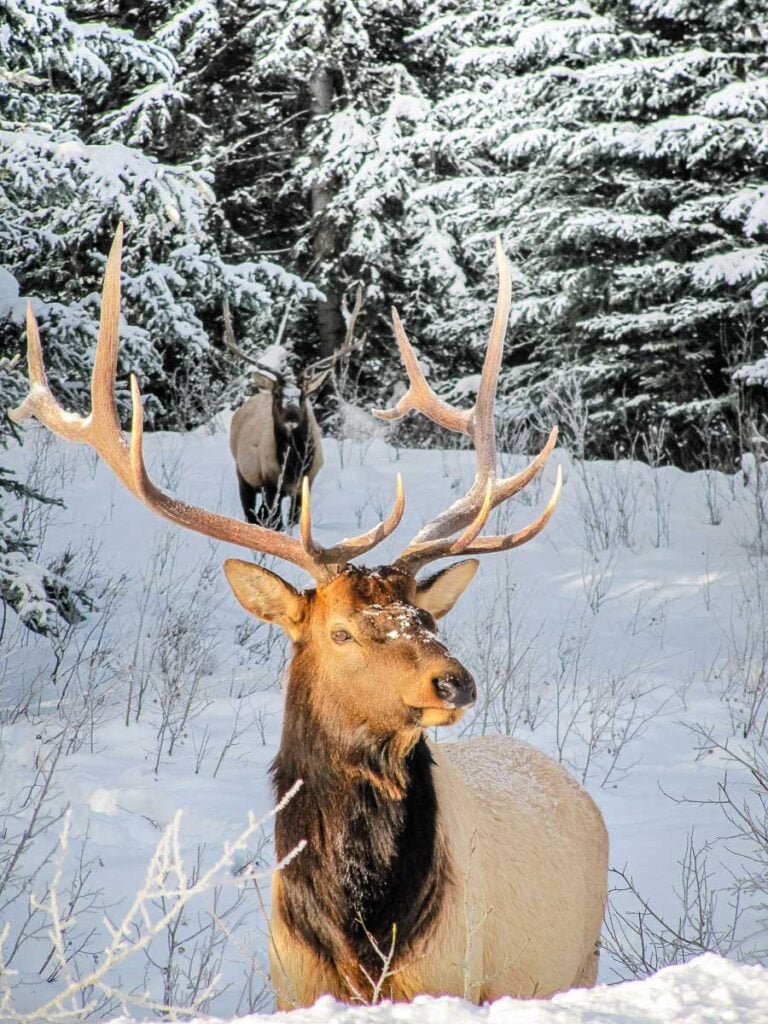
Best time to Visit Banff to Avoid Crowds
To avoid crowds in Banff National Park, you’ll want to visit during the shoulder seasons which are typically the quieter times of the year.
Early spring (April into May) will have less crowds in Banff National Park. While you won’t have the summer crowds to contend with, you may be more limited on what you can see and do. While some higher elevation trails may still be snow-covered and many will still pose some avalanche risk, other areas may also still be closed. For example Moraine Lake Road does not typically open until early June. You may also encounter the occasional snow storm at this time of year.
You can expect that lower elevation trails and town areas to be mostly free of snow and more accessible.

Similarly, in late fall (November into early December) there will be less people visiting Banff National Park. Again at this time, there will be less transportation options compared to in summer and lakes will begin to freeze. Winter sports will just be starting up, but there’s not typically enough snow for all the winter activities.
Dog sledding, skating on Lake Louise and even horse drawn sleigh rides don’t typically start until mid to late December depending on how much snow has fallen. Skiing will have started at the ski resorts, but some areas of the resorts may not be open yet.
It’s also important to know that avalanches also pose a risk this early in the winter season, so you need to know where it’s safe to go and have experience in avalanche terrain with all the necessary gear to venture in avalanche terrain.
While not everyone has the option to avoid visiting in the summer months or around the holidays, you can still enjoy a trip to Banff during those times. I recommend visiting the most popular places on weekdays and during off-peak times to get the most enjoyment out of your time.

Best Time to Ski in Banff
Prime skiing season in Banff National Park typically falls within the winter season, which spans from late November to early April. However, the specific timing for skiing can vary depending on your preferences and the type of skiing experience you’re seeking:
While the ski resorts typically open in November, this is the start of the ski season in Banff. Not all runs and lifts will be open immediately and conditions can be a bit more unpredictable. You can enjoy quieter slopes, and accommodation and lift ticket prices may be lower than during peak season
In mid-December through early January is the holiday season, and Banff’s ski resorts can be bustling with activity. Expect higher prices and larger crowds, especially around Christmas and New Year’s. However, the snow conditions are usually excellent.

Around the third week of February is another busy season as locals have a week off after the Family Day holiday. Late winter often brings sunny days and great skiing conditions. It’s a good time for skiing if you prefer milder temperatures and quieter slopes.
Spring skiing in Banff can be delightful, with longer daylight hours and milder temperatures. You’ll find more sunshine, but be prepared for variable conditions as the snow begins to melt at lower elevations.
The Banff ski resorts, including Sunshine Village, Lake Louise Ski Resort, and Norquay, offer a variety of terrain for skiers of all levels, from beginners to experts.

Best Time to Travel to Banff National Park for Photography
Banff National Park is a photographer’s paradise, offering stunning landscapes and diverse wildlife year-round. The best time of year to travel to Banff for photographers depends on your interests and the type of scenes you want to capture. Here are some considerations for different photography opportunities throughout the year:
In mid September through early October, Banff’s fall foliage is at its most vibrant, with forests and lakeshores bursting with color. It’s also a great time to capture snow capped mountains with the vibrant fall colours, as snow starts to fall at higher elevations.
Wildlife like elk, deer, and bears are frequently seen as they prepare for winter, making it a prime time for wildlife photography. Additionally, the shorter days mean you can enjoy sunrises without the need for an extremely early start.

Winter transforms Banff into a magical snowy wonderland. The snow and ice craft dramatic and unique landscapes, ideal for both landscape and macro photography. With some luck, you can spot wildlife with the snowy landscape creating a stunning backdrop for photography. The clear, long winter nights are also perfect for astrophotography and again, with some luck catching the aurora borealis.
Ensure you have the right gear to protect your equipment from the elements and also to stay warm on long photo shoots.

In spring and as the snow melts, Banff’s waterfalls and rivers reach their peak flow, creating some stunning photography opportunities. Wildlife, particularly with their newborns, are active, offering some impressive wildlife photography.
Summer in Banff is an ideal time to catch alpine meadows with blooming wildflowers, and blue lakes. The long daylight hours extend photo sessions, so expect to be up very early for sunrises and stay up late for sunsets. This season is excellent for capturing both landscape and wildlife images.

Please Support Human Created Content
This post was written by a local who lives just minutes outside Banff National Park. If this post was helpful, and you value getting accurate Banff advice from a real human (not AI), please click here to make a small donation or explore other easy ways support our small business. Every bit makes a difference.
Found this post useful? Save it or share it with your friends!
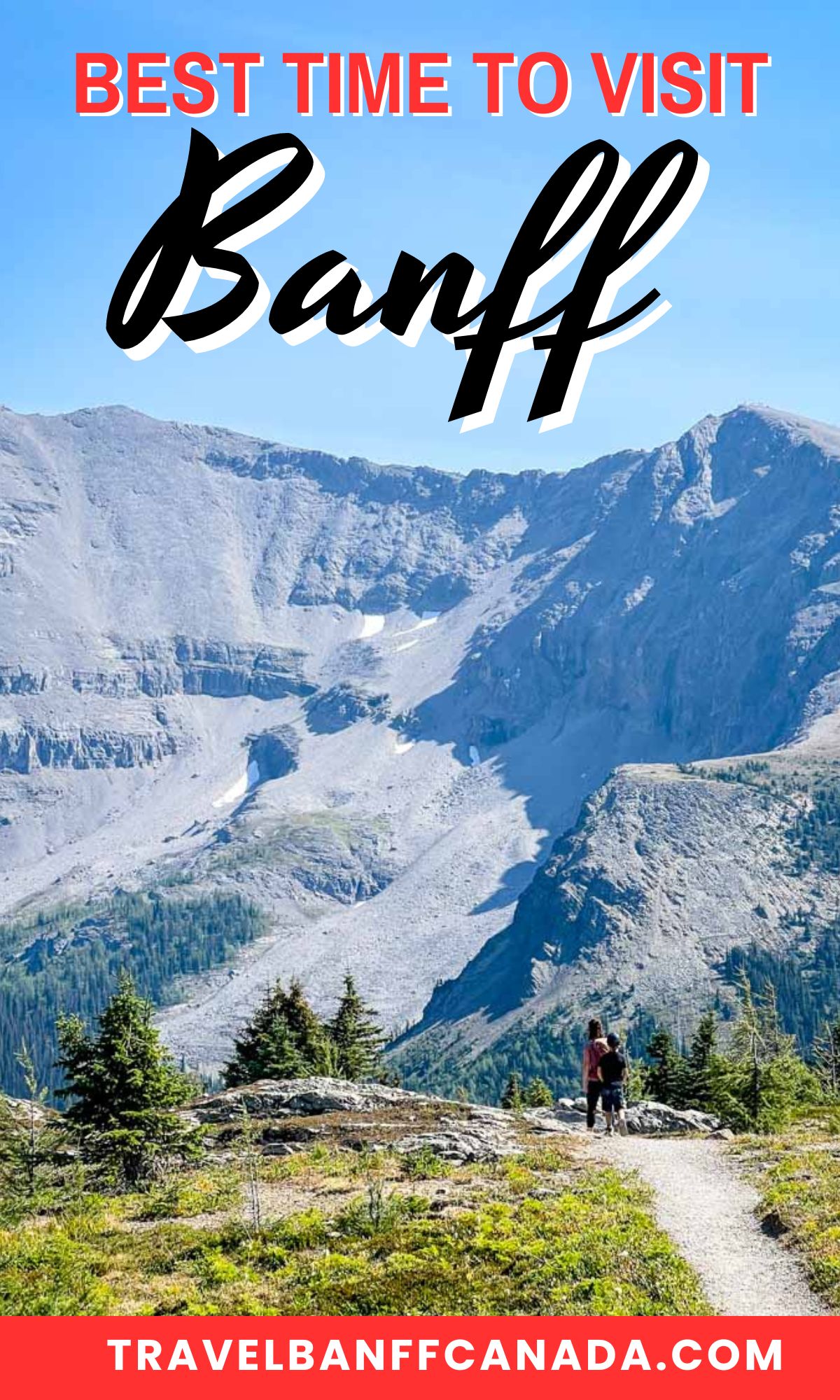
Celine Brewer, a local Canmore resident, is the co-owner of Travel Banff Canada. She has a passion for being out in the mountains any time of year. In the summer, you'll often find her hiking or mountain biking. In the winter, she enjoys cross-country skiing, snowshoeing and winter hiking the most.
As much as she loves the mountains, she also loves travel! When she's not playing outdoors at home, she's either traveling the world with her husband and two kids or working on their other two travel sites: Family Can Travel and Baby Can Travel.

